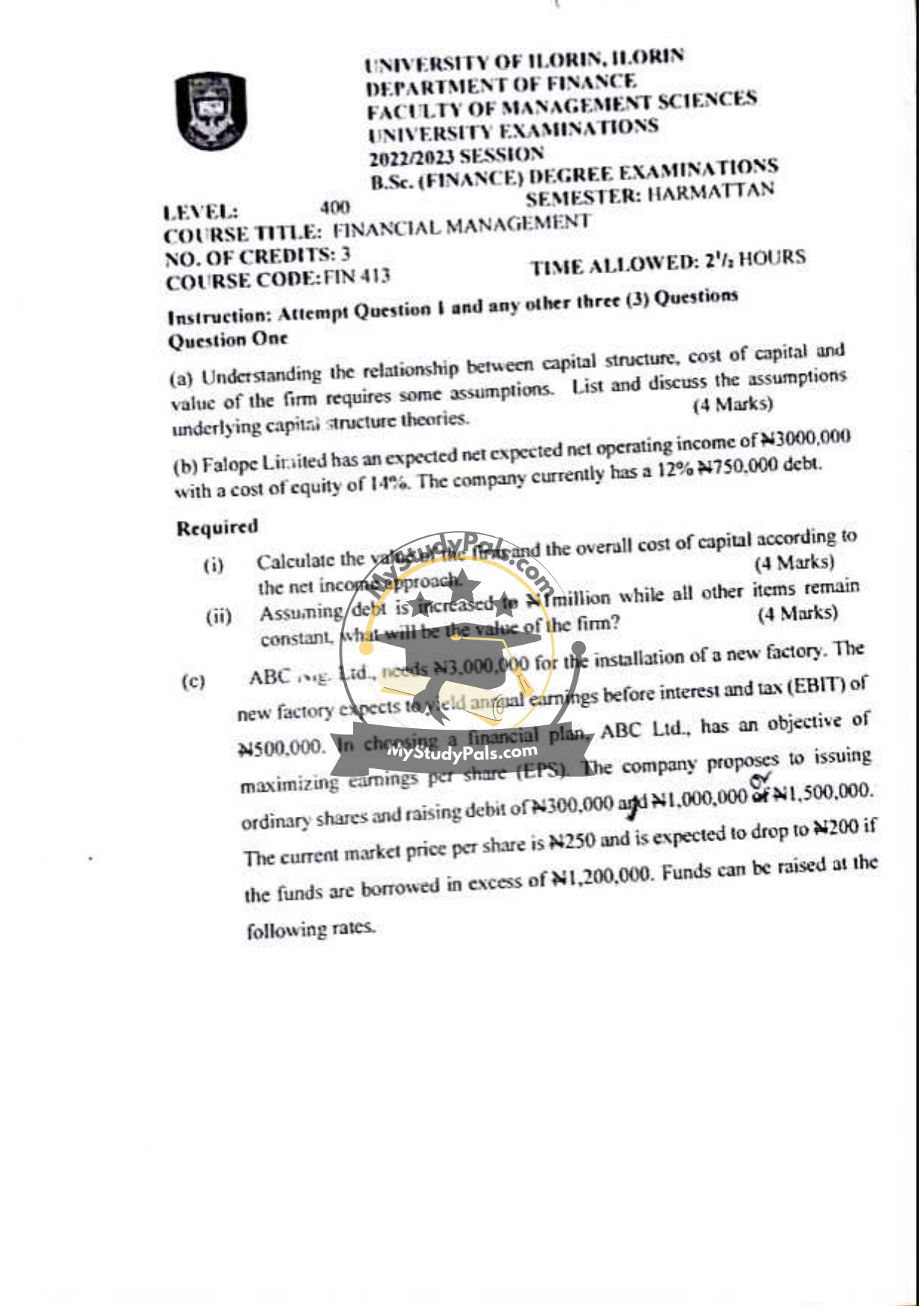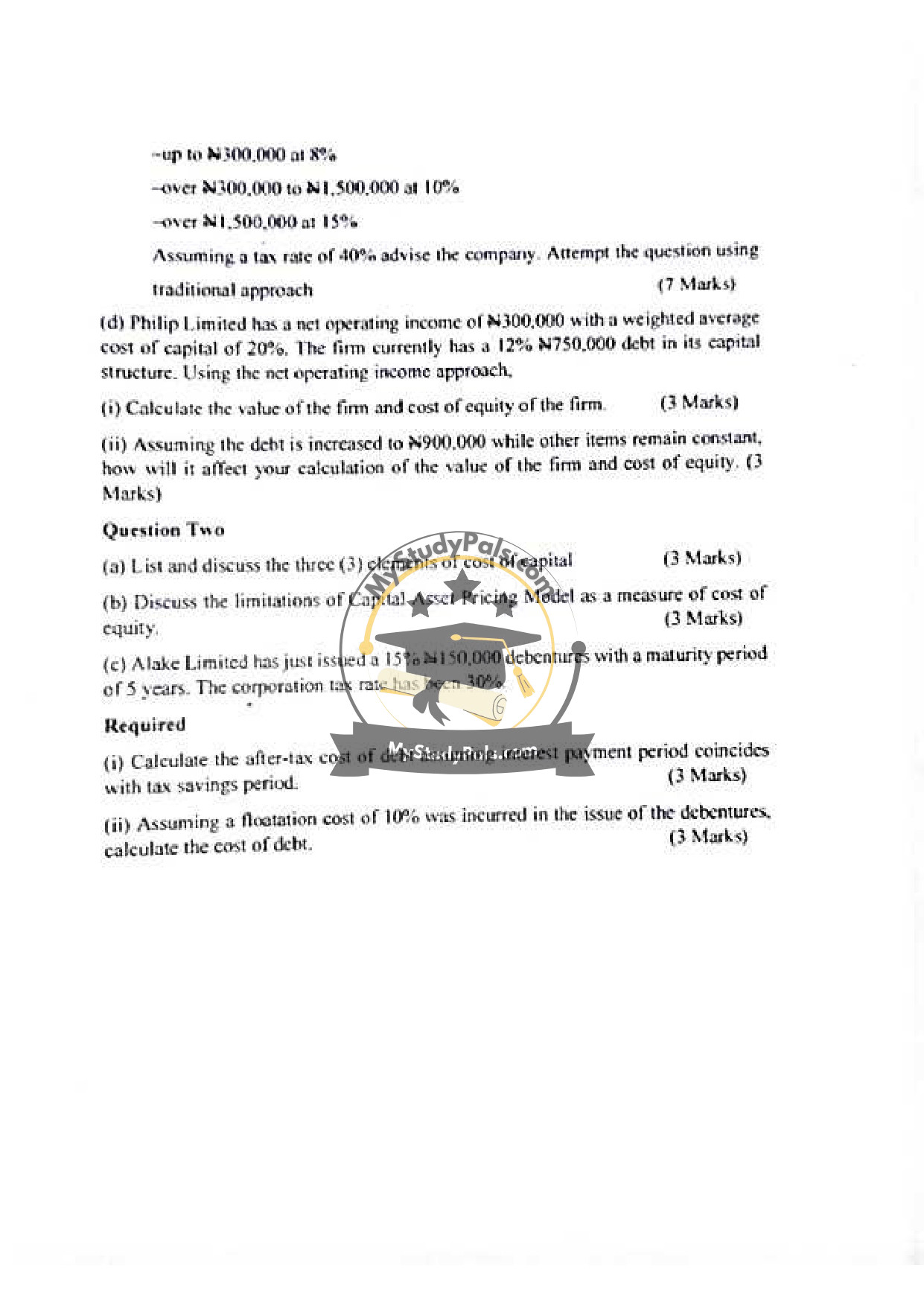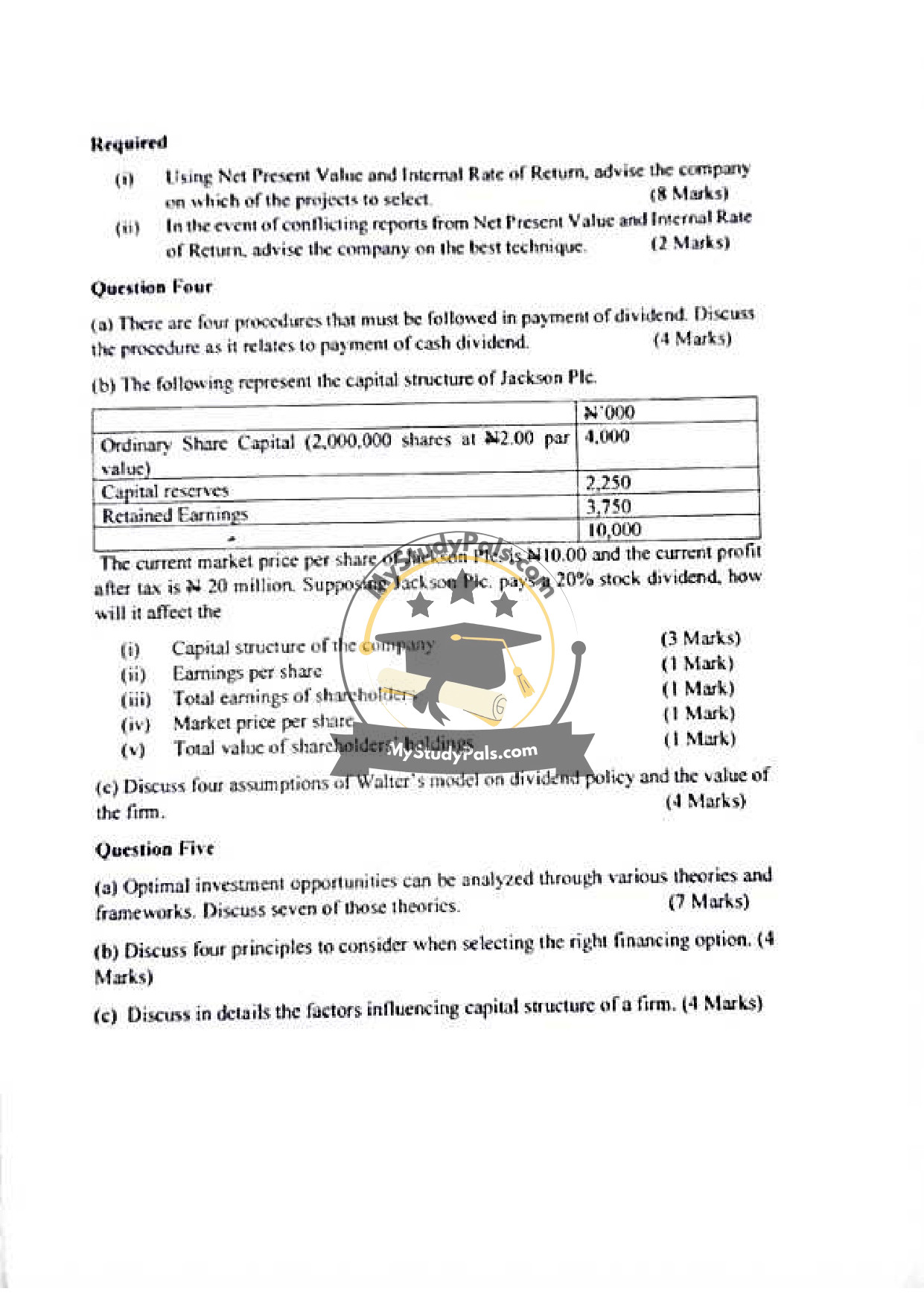ANWSER
—
Question One
(a) Assumptions underlying capital structure theories:
1. No Taxes: Assumes no corporate or personal taxes, implying no tax shield on interest payments.
2. Perfect Capital Markets: No transaction costs, bankruptcy costs, or asymmetric information.
3. Fixed Investment Policy: The firm’s investment decisions are independent of its financing decisions.
4. Homogeneous Expectations: All investors have the same expectations about future earnings and risks.
5. No Dividend Payout: All earnings are retained, and no dividends are paid.
(b) Falope Limited (Net Income Approach):
(i)
– Value of Equity (E) = Net Income / Cost of Equity = ¥300,000 / 0.14 = ¥2,142,857.
– Value of Firm (V) = E + Debt = ¥2,142,857 + ¥750,000 = ¥2,892,857.
– Overall Cost of Capital (Ko) = EBIT / V = ¥300,000 / ¥2,892,857 ≈ 10.37%.
(ii)
– If debt increases to ¥1,000,000, equity remains ¥2,142,857 (assuming no change in NI).
– New V = ¥2,142,857 + ¥1,000,000 = ¥3,142,857.
(c) ABC Ltd. (Traditional Approach):
– Objective: Maximize EPS.
– Options:
1. Debt ¥300,000 (8%) + Equity ¥2,700,000:
– Interest = ¥24,000; EBIT = ¥500,000; EBT = ¥476,000; Tax (40%) = ¥190,400.
– Net Income = ¥285,600; Shares = ¥2,700,000 / ¥250 = 10,800.
– EPS = ¥285,600 / 10,800 ≈ ¥26.44.
2. Debt ¥1,000,000 (10%) + Equity ¥2,000,000:
– Interest = ¥100,000; EBT = ¥400,000; Tax = ¥160,000.
– Net Income = ¥240,000; Shares = 8,000.
– EPS = ¥30.00.
3. Debt ¥1,500,000 (15%) + Equity ¥1,500,000:
– Interest = ¥225,000; EBT = ¥275,000; Tax = ¥110,000.
– Net Income = ¥165,000; Shares = 6,000.
– EPS = ¥27.50.
– Advice: Choose Option 2 (Debt ¥1,000,000) for highest EPS (¥30.00).
(d) Philip Limited (Net Operating Income Approach):
(i)
– Value of Firm (V) = EBIT / Ko = ¥300,000 / 0.20 = ¥1,500,000.
– Value of Equity (E) = V – Debt = ¥1,500,000 – ¥750,000 = ¥750,000.
– Cost of Equity (Ke) = (EBIT – Interest) / E = (¥300,000 – ¥90,000) / ¥750,000 = 28%.
(ii)
– If debt increases to ¥900,000:
– V remains ¥1,500,000 (NOI approach assumes V is constant).
– New E = ¥1,500,000 – ¥900,000 = ¥600,000.
– New Ke = (¥300,000 – ¥108,000) / ¥600,000 = 32%.
—
Question Two
(a) Elements of Cost of Capital:
1. Cost of Debt: After-tax interest rate on borrowed funds.
2. Cost of Equity: Return required by shareholders (e.g., via CAPM or Dividend Growth Model).
3. Cost of Preferred Stock: Dividend yield on preferred shares.
(b) Limitations of CAPM:
1. Assumes perfect markets (no taxes, transaction costs).
2. Relies on historical beta, which may not predict future risk.
3. Ignores unsystematic risk (firm-specific factors).
(c) Alake Limited (Cost of Debt):
(i) After-tax cost = 15% × (1 – 0.30) = 10.5%.
(ii) With 10% flotation cost:
– Net proceeds = ¥150,000 × 0.90 = ¥135,000.
– After-tax cost = (¥22,500 + (¥150,000 – ¥135,000)/5) / ¥135,000 ≈ 12.22%.
(d) Sanya Olu Limited (Cost of Equity):
– Use Dividend Growth Model:
– Growth rate (g) = (66k/40k)^(1/5) – 1 ≈ 10.5%.
– Ke = (D1 / P0) + g = (66k × 1.105 / ¥1.90) + 0.105 ≈ 48.3%.
—
Question Three
(a) Adelson Limited (Project Viability):
– NPV Calculation:
– Annual cash flows adjust for inflation (e.g., Year 1: (100 – 50) × 4,000 – 40,000 = ¥160,000).
– Discount at 18%: NPV ≈ ¥160,000/(1.18) + … – ¥400,000.
– If NPV > 0, accept.
(b) Hassan Plc. (NPV vs. IRR):
(i)
– Project A NPV: ¥80,000/(1.15) + ¥82,000/(1.15)^2 + … – ¥200,000 ≈ Positive.
– Project B NPV: Higher NPV → Choose B.
– IRR: Project B’s IRR > 15% → Choose B.
(ii) Prefer NPV (reinvests at cost of capital; avoids IRR’s multiple rates issue).
—
Question Four
(a) Dividend Payment Procedures:
1. Declaration Date: Board announces dividend.
2. Record Date: Shareholders registered by this date receive dividend.
3. Ex-Dividend Date: Shares traded without dividend entitlement.
4. Payment Date: Dividend is paid to shareholders.
(b) Jackson Plc. (Stock Dividend Impact):
(i) Capital reserves decrease; ordinary share capital increases.
(ii) EPS decreases (more shares outstanding).
(iii) Unchanged (total earnings remain ¥20 million).
(iv) Market price per share drops (e.g., ¥10 → ~¥8.33).
(v) Unchanged (value adjusts proportionally).
(c) Walter’s Model Assumptions:
1. All financing is via retained earnings.
2. Constant return (r) and cost of capital (Ke).
3. Infinite life of the firm.
4. No taxes or flotation costs.
—
Question Five
(a) Investment Theories:
1. Net Present Value (NPV)
2. Internal Rate of Return (IRR)
3. Payback Period
4. Profitability Index
5. Modigliani-Miller Theorem
6. Pecking Order Theory
7. Agency Cost Theory
(b) Financing Principles:
1. Match financing duration with asset life.
2. Minimize cost of capital.
3. Maintain financial flexibility.
4. Consider tax implications.
(c) Capital Structure Factors:
1. Tax Shield: Benefit from debt interest deductions.
2. Business Risk: Volatility of earnings.
3. Financial Flexibility: Ability to raise funds quickly.
4. Market Conditions: Interest rates and investor sentiment.
—





